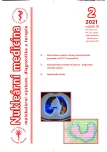Optimization of radiation protection of medical staff at PET/CT departments
Authors:
Renáta Kohutová 1,2; Vítězslav Jiřík 1,2; Martin Havel 1,3; Vojtěch Ullmann 1,2,3
Authors‘ workplace:
Lékařská fakulta, Ostravská univerzita
1; Ústav epidemiologie a ochrany veřejného zdraví, Ostravská univerzita
2; Klinika nukleární medicíny, Fakultní nemocnice Ostrava, ČR
3
Published in:
NuklMed 2021;10:24-30
Category:
Original Article
Overview
It is responsibility of every workplace that utilize ionizing radiation sources under medical exposure to abide the principles of radiation protection, including compliance with the ALARA rule (As Low As Reasonably Achievable). The aim of this thesis was to assess the level of optimization of radiation protection of medical professionals on PET/CT departments with respect to the received personal dose, personal protective aids utilization, construction of the premises and also the experience and skills of the workers. All PET/CT and PET/MR departments in the Czech Republic, including two non-PET sites, were asked to participate in the study by completing two electronic questionnaires and providing other important information. Out of the total number of 22 surveyed departments in the Czech Republic and Slovakia 18 workplaces responded the first questionnaire. The return rate of the questionnaire 2 was 55,6 %. Subsequently, 10 sites were included in the study. Subsequently, the obtained personal dosimetry data (respecting GDPR), information about administered activities, responses to the subjective evaluation of the situation of executives and also received plans of the construction of the premises were processed and compared. A regression analysis was used for statistical assessment. The sets of values were compared by Mann-Whitney and Kruskal-Wallis non-parametric tests. For each worker the average effective and equivalent doses in relation to the applied activity was calculated as well as the collective dose for each workplace. In the next step, the received value of Hp(10) and HT was calculated from 1 GBq per worker (in µSv). The results revealed differences in the level of radiation protection between individual workplaces. Equipment and sufficient staff play a major role. Differences were also found in the dose received on the skin of the hands. The assumption that utilization of positron radiopharmaceuticals is connected to a greater radiation burden has not been confirmed, as well as that the acquisition of automatic delivery systems does not decrease the collective dose automatically. Practical skills and experience of employees are important. Specific recommendations to improve the level of optimization were proposed for individual departments.
Keywords:
radiation protection – Optimization – PET/CT
Sources
- UNSCEAR, Program OSN pro ochranu životního prostředí. Ionizující záření, účinky a zdroje. [online]. [cit. 2019-11-12]. Dostupné na: https://www.sujb.cz/fileadmin/sujb/docs/radiacni-ochrana/dokumenty/Radiation-InsidePart-Czech-Feb_2017-1.pdf
- Hušák V. Radiační ochrana pro radiologické asistenty. Olomouc: Univerzita Palackého v Olomouci, 2009, 138 p
- Drábková A. Historie radiační ochrany v ČR: 10 let Státního ústavu radiační ochrany 1995-2005. Praha: Státní ústav radiační ochrany, 2006, 84 p
- Zákon č. 263/2016 Sb., atomový zákon. [online]. [cit. 2019-12-30] https://www.sujb.cz/legislativa/nove-atomove-pravo
- Vyhláška 422/2016 Sb., Vyhláška o radiační ochraně a zabezpečení radionuklidového zdroje. [Citace:30 12.2019]. Dostupné na: https://www.sujb.cz/legislativa/nove-atomove-pravo
- Kubinyi J, Sabol J, Vondrák A. Principy radiační ochrany v nukleární medicíně a dalších oblastech práce s otevřenými radioaktivními látkami. Praha: Grada, 2018, 308 p
Labels
Nuclear medicine Radiodiagnostics RadiotherapyArticle was published in
Nuclear Medicine

2021 Issue 2
Most read in this issue
- Subsegmental pulmonary embolism – diagnosis and clinical significance
- Optimization of radiation protection of medical staff at PET/CT departments
- Transient FDG lymph node positivity after vaccination against COVID-19
